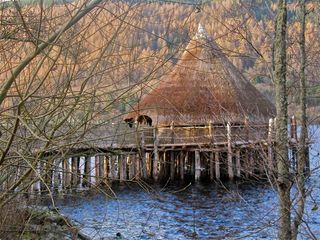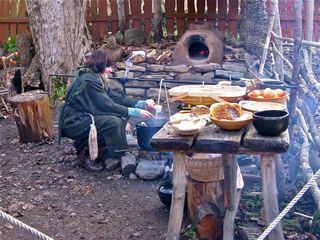We had such a blast at the Crannog Center for Samhain (Halloween) that we vowed to go back so we could actually see the crannog in the daylight. What's a crannog?
Crannogs are a type of ancient loch-dwelling found throughout Scotland and Ireland. Most are circular structures that seem to have been built as individual homes to accommodate extended families. Other types of loch settlements are also found in Scandinavian countries and throughout Europe.
 We made it to the Center on the last day they were open until next spring. They were celebrating the day with a Wild Harvest Food Festival, featuring only period Celtic foods. We ate pumpkin soup, lamb stew, barley with rosemary, and bread baked in a wood fired mud oven. Owen was excited that he found a small rock in his bread -- he felt it added to the authenticity. We couldn't for the life of us imagine how the bread lady was getting anything to bake in that small mound on the ground with fire inside, but she was pretty good at it. She also brought some heather honeycomb from her bees for the bread.
We made it to the Center on the last day they were open until next spring. They were celebrating the day with a Wild Harvest Food Festival, featuring only period Celtic foods. We ate pumpkin soup, lamb stew, barley with rosemary, and bread baked in a wood fired mud oven. Owen was excited that he found a small rock in his bread -- he felt it added to the authenticity. We couldn't for the life of us imagine how the bread lady was getting anything to bake in that small mound on the ground with fire inside, but she was pretty good at it. She also brought some heather honeycomb from her bees for the bread.
We took a tour of the center and the crannog dwelling out on the water. The dwelling was built as traditionally as possible, reproducing the original techniques, as part of an archaeological experiment by the Scottish Trust for Underwater Archeology. At the Center, a husband-and-wife team, both underwater archaeologists, promote the research, recording, and preservation of Scotland's underwater heritage. Imagine that -- underwater heritage.
 Our guide was Daniel, who was cheerful and wonderfully knowledgeable, and also freezing in costume with no gloves. He explained that the crannogs on Loch Tay were around 2600 years old. A crannog would be used for 200 years or more, being repaired as needed both above, and below, the water. As the pilings supporting the roundhouse rotted away they were replaced, until, over time, there was no more room to squeeze more pilings into the clay riverbed. At that point the inhabitants would pile rocks under the dwelling to hold it in place above the water, and when that ceased to anchor the house they would pack up and move on to a new location. After the crannog was abandoned it would eventually collapse,
Our guide was Daniel, who was cheerful and wonderfully knowledgeable, and also freezing in costume with no gloves. He explained that the crannogs on Loch Tay were around 2600 years old. A crannog would be used for 200 years or more, being repaired as needed both above, and below, the water. As the pilings supporting the roundhouse rotted away they were replaced, until, over time, there was no more room to squeeze more pilings into the clay riverbed. At that point the inhabitants would pile rocks under the dwelling to hold it in place above the water, and when that ceased to anchor the house they would pack up and move on to a new location. After the crannog was abandoned it would eventually collapse,  creating an island in the loch. There are crannog islands all over Scotland, with trees and birds living on them. It's amazing that these exist because of a 3000 year-old house that used to be there.
creating an island in the loch. There are crannog islands all over Scotland, with trees and birds living on them. It's amazing that these exist because of a 3000 year-old house that used to be there.
The crannog ruins in Loch Tay have been well preserved by the cold peaty waters. Pots, utensils, pilings, oars and even a wooden butter dish have been discovered at the site. How do they know it was a butter dish, you ask? No it didn't have a cow cover on it. There was some greyish slime inside the dish. The archaeologists had it analyzed. It was butter. 2600 year-old butter.
Daniel also showed us iron-age techniques and tool for wood working, grain grinding and fire making. You know how when you were a kid you thought you could rub two sticks together and make a fire. It never worked - did it? Daniel did it! So Cool!
Really fun day. Glad we made it before their season was over.
Oh yeah - and Brenna shot a bulls eye in archery. Just saying...